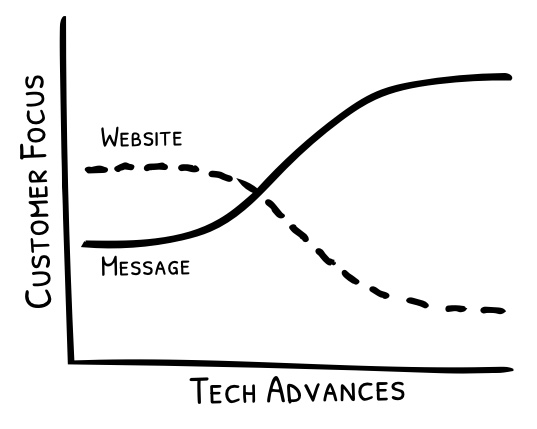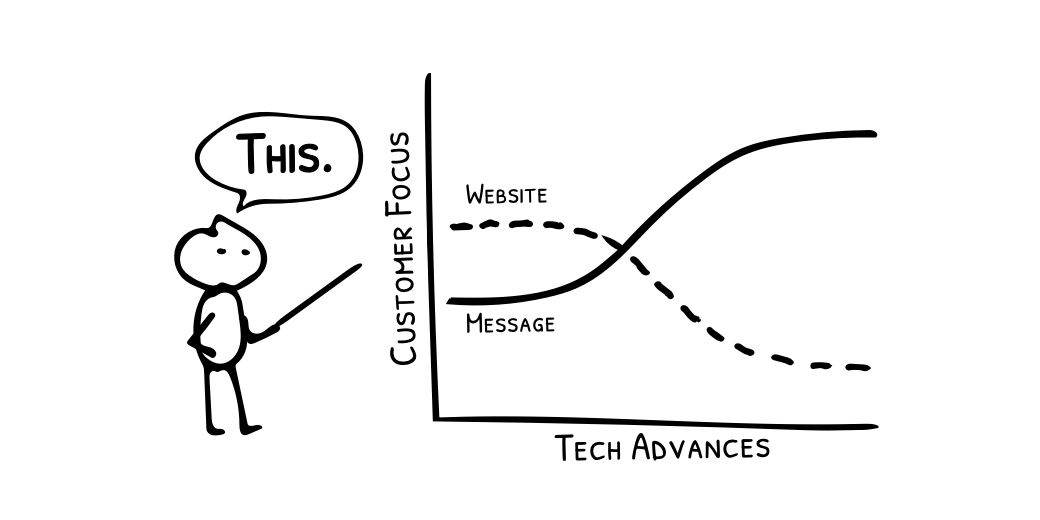It’s never been easier to create a website. There are a million tools out there to simplify the process from Squarespace to Shopify.
Within a day you can create a basic site that works well across laptops, tablets, and phones.
We take that functionality for granted, but these are highly technical tasks. It wasn’t long ago that this process required deep levels of expertise to develop on even a basic level.
Now the barriers are low and the tools are affordable.
It almost seems too good to be true.
And it kind of is.
These tools help solve how you can communicate with customers. But they don’t help with what you communicate to customers.
As the challenge of building a site drops, the importance of the message your business communicates becomes even higher.

In other words, if every business can now create a decent looking site then it no longer serves as a point of differentiation.
This means you can’t win the trust of a new customer by checking off that box. At best, all you can do is not-lose someone.
New customers can now be more efficient with their evaluation of a business. They can point their laser focus right at the heart of the matter:
“How do you benefit me?”
The problem you address for customers has always been the most important question for any business to answer. Now, it can get the focus it deserves.
Business owners can waste less time worrying about how to build a site. They can reallocate those mental and financial resources on how to better connect with customers.
That’s how business should be! Put more focus on ways to deliver value and solve problems. Put less focus on basic right or wrong challenges like “Does our site work on mobile?”
That leads us to an important next question:
How can we improve the way we craft an effective message for customers?
The Dangers Of “Winging It”
Ask a non-technical person to code a website from scratch and the response will likely be:

(via Heavy)
When it comes to coding, people are quick, and sometimes oddly proud to self-identify as being non-technical.
They believe this is a job best left to a skilled professional.
But ask that same person to write the key messages for their business and you get:

(via Tenor)
It’s subtle, but that expression is pure confidence.
This is because people often think it’s simple to write an effective message for their business themselves. They know what their business does. They write lots of other things like emails and tweets. All they have to do is say it. How hard can it be?
But businesses that have been around a while know the dangers of “winging it”.
Lack of customer interest. Lack of engagement. Lack of conversions.

(via Tenor)
So, they hire agencies, consultants, and copywriters to help craft those messages. They recognize that just like a website, building an effective message also requires skill.
And they know a vague, confusing message can wreck a customer’s desire to engage as easily as a bad website.
A customer’s judgement happens within seconds. If your messages don’t instantly convey how that person’s life will improve with what you provide, then you’ve lost.
How To Craft Effective Messages
Like websites, messages have structure too.
You create effective messages from the key building blocks of your business:
- The pain points you’ll improve in your customers’ lives
- Points of differentiation between you and other businesses
- How you deliver your value
- The tone of voice your customers want to hear
Messages should be around a particular length so that they’re easy to read and digest.
Messages should include key terms related to your business so customers can find you.
Messages shouldn’t be basic descriptions. They need to convey the benefits your business provides to your customers.
Oh, and don’t forget the sentiment of the message too.
That’s a lot of stuff to juggle.
But if those fundamental elements of effective messages are easy to access and use, then more people will take advantage of them.
And with better communication, more businesses can survive and help the people they aim to serve.
Here’s The Help
If you want access to a tool to help craft effective messages, check out StratPack.
It provides a mix of best practices models and AI tools to guide you.
It will help you identify the core elements of your business, craft great messages, and test them before you put them out into the wild.

Enough chitchat, see for yourself!
We’re always happy to answer questions about StratPack, but the best thing you can do is try it for yourself. Lucky for you, it’s totally free to get started, so give it a shot and see how fast and easy it is to create great messaging!

